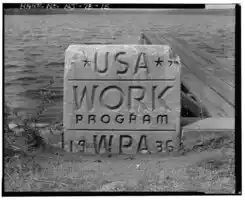
For those encountering obstacles in their family history research, an often-overlooked yet profoundly valuable resource warrants consideration: the records of the Works Progress Administration (WPA). Established during the Great Depression as part of President Franklin D. Roosevelt’s New Deal,[1] the WPA—later renamed the Work Projects Administration—not only provided employment to millions of Americans but also produced an extraordinary collection of historical documentation. These records, encompassing interviews, surveys, and meticulously compiled indexes of local government archives, represent a treasure trove of information, offering unparalleled opportunities for genealogical discovery.
Research your ancestors on MyHeritage
Understand What the WPA Did and Why It Matters for GenealogyUnderstand What the WPA Did and Why It Matters for Genealogy
Before diving into the records, it helps to understand why they were created and how they can benefit your search. Founded in 1935, the WPA was responsible for large-scale public works projects, but it also funded “make-work” endeavors in fields like art, writing, and historical documentation. One of their notable contributions was conducting inventories and surveys of local archives, cemeteries, churches, and historical documents. By doing so, they created indexes, bibliographies, and transcripts—many of which still serve as finding aids for researchers today.
Why it matters:Why it matters:
- Local Focus: WPA field workers documented sources at a county and town level, which can help pinpoint your ancestor’s location and life events.
- Uncommon Sources: They indexed courthouse documents, church records, and cemetery lists that may not be otherwise well-publicized or easy to access.
- Contextual Clues: WPA projects included oral histories and local history narratives, providing cultural and community context that can add depth to your family story.
Identify the Types of WPA Records Useful for GenealogyIdentify the Types of WPA Records Useful for Genealogy
WPA projects generated several categories of records. Familiarizing yourself with these will help you narrow your search.
- Historical Records Surveys (HRS): Inventories of public records housed in courthouses, town offices, libraries, and churches. These surveys can lead you to marriage certificates, wills, deeds, and other local documents pertinent to your ancestors.
- Cemetery and Church Inventories: WPA workers cataloged burial sites and church registers, which can reveal birth, marriage, and death information about your ancestors.
- Oral Histories and Narratives: Some WPA projects funded interviews with community members, including formerly enslaved individuals, immigrants, and longtime residents. These narratives can provide personal details and unique insights into your family’s past.
- Guidebooks and Local Histories: The WPA American Guide Series offered historical, cultural, and social accounts of counties, cities, and states—essential context that helps bring your ancestors’ environment to life.
Locate Repositories That Hold WPA RecordsLocate Repositories That Hold WPA Records
While the WPA no longer exists, its records can be found across a variety of institutions. You’ll need to cast a somewhat wide net.
- State Archives and Libraries: Many state archives maintain sets of WPA surveys, indexes, and histories that cover multiple counties. Check their online catalogs or contact archivists directly.
- University Special Collections: Academic libraries often house WPA materials relevant to local or state history. Search their online finding aids or digital repositories.
- County Historical Societies: Local historical and genealogical societies frequently preserve WPA inventories of church records, probate files, and cemetery listings for their region.
- The National Archives (NARA): Though much of the WPA’s primary administrative paperwork is held at NARA, some research tools and indexes may be accessible through their collections. Their website and staff can guide you to these materials.
- Digital Collections and Online Databases: Various genealogy websites (such as FamilySearch.org) occasionally incorporate WPA inventories or transcripts into their digital collections. Use targeted keyword searches like “WPA Historical Records Survey [State/County]” or “WPA Cemetery Inventory [Location].”
Request and Access DocumentsRequest and Access Documents
Once you’ve identified a likely repository, find out how to access the materials.
- Check Online Finding Aids: Many repositories provide guides that describe collections and often include WPA materials. Note down series numbers, collection names, and call numbers.
- Contact Archivists and Librarians: If you can’t find what you need online, reach out via email or phone. Archivists can confirm what’s available and advise on the best way to access documents (onsite visits, digital copies, or interlibrary loan).
- Visit In Person When Possible: For detailed, hands-on research, plan a trip to the archive or library. Be prepared with a research plan, including your ancestors’ full names, approximate dates, and locations.
Analyze the Records for Genealogical CluesAnalyze the Records for Genealogical Clues
When you have WPA records in hand—be they indexes, inventories, or narratives—dig deep to extract as much detail as possible.
- Correlate with Known Facts: If an index shows a deed record from your ancestor’s county, use that information to track down the original deed. If you discover a cemetery listing with a family surname, pursue the actual grave marker or death certificate.
- Follow Cross-References: Many WPA inventories will reference other local archives or specific record sets. Use these breadcrumbs to move to original documents that can confirm relationships and vital events.
- Add Social and Cultural Context: WPA narratives and local guides can enrich your family history beyond mere names and dates. This context helps you understand your ancestors’ community, hardships, and day-to-day lives.
Keep Detailed Notes and Source CitationsKeep Detailed Notes and Source Citations
Like any genealogical endeavor, thorough documentation is crucial.
- Record Your Sources: When you find an ancestor listed in a WPA cemetery survey, note the collection name, repository, and file number.
- Maintain Consistent Recordkeeping: Store transcripts, notes, and digital images in organized folders. Use genealogy software or online family trees to incorporate these details seamlessly.
Broaden Your Search Beyond One LocaleBroaden Your Search Beyond One Locale
If your ancestors moved, consider looking for WPA inventories in multiple states or counties. The WPA’s reach was national, and their surveys often overlapped geographically.
ConclusionConclusion
The WPA left behind an incredible variety of resources that can fill in the gaps in your genealogical research. By understanding what types of records were created, where to find them, and how to use them to uncover new leads, you can tap into a less-explored but highly rewarding facet of family history. With careful planning, thorough documentation, and some persistence, WPA records can guide you past longstanding brick walls and lead you closer to a fuller understanding of your family’s story.
See alsoSee also
Learn more about the Works Progress Administration (WPA)Learn more about the Works Progress Administration (WPA)
- Record Group 69 - Records of the Works Progress Administration (WPA). National Archives and Records Administration
- The Historical Records Survey of the Works Progress Administration. Learn Genealogy
- Where to Look for Works Progress Administration (WPA) Records. Family Tree Magazine
References
- ↑ Arnesen, Eric (2007). Encyclopedia of U.S. Labor and Working-Class History. Vol. 1. New York: Routledge. p. 1540. ISBN 9780415968263.

